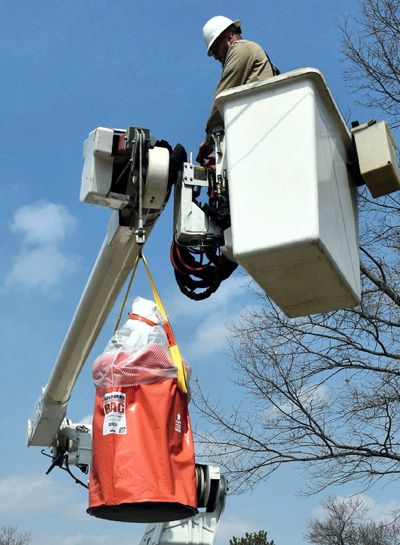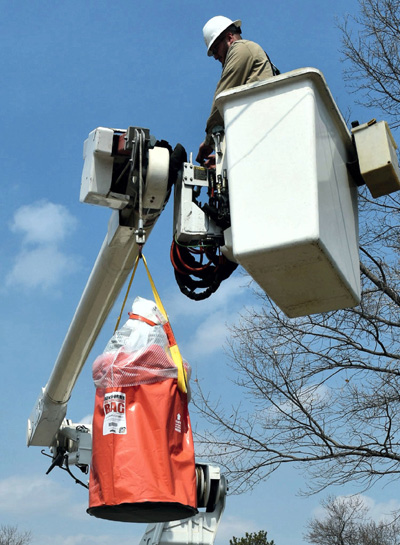
Safe Transportation of Leaking Transformers

“Back in the day, we put leaking pots in a trash bag, and we were good to go!”
For hundreds of Incident Prevention readers, that remark isn’t totally unheard of. And in reality, it’s not far off from what some do when leaking transformers are transported or stored prior to reclamation or disposal. However, that will not save a utility from the fines and reclamation actions it could face if transportation or environmental regulatory authorities get involved.
Utilities fall under numerous environmental regulations, including the Toxic Substances Control Act of 1976. Since the 1970s, public demand for environmental safety also has led to numerous additional requirements. The problem is that the various agencies, with their overlapping environmental requirements, don’t specifically or clearly detail the issues that utilities face with aerial and padmount transformers and other line equipment that are insulated with a variety of fluids or oils. Individual states also may have regulations that exceed federal standards, potentially increasing utility exposures. What is clear is that if you dump oil, no matter what kind it is, you will face fines and reclamation costs far beyond what the cost of compliance would have been.
Ultimately, utilities must be concerned about the greatest exposure to environmental enforcement, and that is field-employed transformers and switchgear that contain chemicals. Transportation and storage of fluid-insulated apparatus are covered by numerous U.S. Environmental Protection Agency standards, including the Resource Conservation and Recovery Act, as well as standards from the U.S. Department of Transportation and the Pipeline and Hazardous Materials Safety Administration. But even more important than regulations may be your customers’ impressions of your environmental stewardship. These days, the public has become more sensitive to environmental risk exposures. Oil dripping from trucks or apparatus impacts the public perception of a utility.
Still, public perception notwithstanding, no utility wants to even accidentally contaminate the environment. And certainly, no utility wants to be faced with cleaning up a miles-long trail of transformer oil, especially when the fine for contamination can be over $37,000 a day for an unremedied condition.
An Industry Scenario
Consider this scenario: A utility plans a contractor-executed retrofit and upgrade that requires replacing more than 100 transformers. Most of the transformers are over 40 years old. They have been surveyed, and all of them are less than action level for polychlorinated biphenyls – or PCBs – but many of the transformers are leaking. The contractor uses heavy black plastic trash bags to contain several leaking transformers in a load of 20 transformers; they are then put on a stake-body truck for transport back to the utility’s yard. During transport, the transformers cut through the bags on the checker-plate deck, and a visible oil drip catches the attention of a member of the public, who reports it to the authorities. The contractor gets shut down, and the city, county and state environmental agencies, as well as federal transportation enforcement, get involved with the utility’s lawyers. The utility is compelled to hire a specialty legal firm to help them with environmental law.
Once the contractor is back up and running, they decide to abandon the heavy black plastic trash bags and start using an overstock of leftover fertilizer transport bags since they are made with heavy material, are rated for a ton of weight, are waterproof and have lifting straps sewn onto them. Plus, a salesman the contractor talked to said they would work just fine. The problem is that intent, advice and remedy do not always meet regulatory requirements. That’s why the state’s transportation enforcement eventually stopped another transformer load and put the contractor out of service – again. The enforcement agent ticketed the driver for load violations, explaining that the fertilizer transport bags – known as flexible intermediate bulk containers, or FIBCs – are noncompliant for transporting transformers on two counts: they are not rated for liquids and they cannot be used with a package (transformer) inside them. Unfortunately, nobody at the utility knew that, and the contractor sought cheap advice from a poorly informed source. This project will now cost hundreds of thousands more than planned, and that doesn’t take into account the public relations and political issues generated by the TV news story that opened with a close-up of oil on the public street right outside the utility’s yard.
This entire situation started with a box of trash bags purchased at the local home store. The contractor went from simply purchasing trash bags to repurposing equipment as the method to solve a problem. And it’s true that repurposing works well on television remodeling shows. Who wouldn’t want an old farmhouse door repurposed as a rustic table? But with OSHA and other regulatory agencies, the manufacturer’s application and design purpose, which is listed on equipment labels and instructions, means that repurposing can be a violation of law and even a hazard to employees.
While the scenario above is not exact, every element of the story is. Andax Industries sees these things happen every year. There are many utilities that understand the requirements for safely handling leaking transformers and have employed the use of transformer containment bags for many years. But there also are those that call us, already in a bind, having found themselves at the mercy of enforcement and desperate to become compliant as soon as possible – after the damage has already been done.
About FIBCs
In some segments of industry, including utilities, FIBCs have been employed as a means to lift and move transformers being removed from service. The issue is that these products are not rated, designed, tested or approved for use with utility transformers. FIBCs are designed for granular/flowable materials. You may be familiar with this type of bulk packaging; it can be used to hold contaminated soils from a spill site or perhaps as a bulk packaging solution for bulk fertilizers or a shipment of grass seed at a project site. When used properly – for their intended purpose – FIBCs are a great packaging solution. And for contaminated soils and other approved applications, they can and do meet U.S. DOT requirements for transportation.
As with all things, however, there are caveats; the phrase “for their intended purpose” is one of the caveats here. FIBCs are designed, tested and rated for use with flowable materials. Utility and contractor employers are charged by OSHA, the U.S. DOT and other regulatory agencies to understand and comply with many standards – and that means research. Let’s say you are told by a supplier that you can use an FIBC as a form of fluid containment, or that you can safely lift a transformer in an FIBC; that doesn’t make doing so appropriate or legal. As we are always being reminded, those agencies that enforce those laws don’t approach equipment vendors when something goes wrong on a job site; they go directly to the employer. That’s because employers are expected to consult with regulatory agency documents and manufacturer design data that establish both the use and limits of specialty-purpose equipment.
There are three primary reasons FIBCs should not be used to move transformers, whether they’re leaking or not:
- FIBCs are designed, manufactured, tested and certified for flowable materials – and a transformer is not a flowable material.
- Transportation rules prohibit using FIBCs with inner packaging, which occurs when an FIBC is used to transport a transformer.
- FIBCs may well be waterproof, but they are not permitted for use in the containment or transport of liquids.
Don’t Stop at Seeking Advice
The utility industry has a lengthy safety and environmental history, and many procedures are familiar to workers because they have been in place for such a long time. As environmental rules have evolved, the industry has worked to acquire new levels of knowledge and experience to meet the sometimes-confusing expectations of regulatory agencies. This is where the employer, typically depending on safety personnel, must do the required research to develop compliant methods for issues like environmental protection and OSHA compliance.
It’s OK to seek the advice of vendors and manufacturers of industry tooling and equipment. That’s what we do – provide solutions. Often that means fabrication of new tools, equipment and methods to meet employers’ needs. But don’t stop at seeking advice. Ask your vendor representatives which agencies regulate the topic and request documentation of the vendor’s development, application and compliance data. That’s not the end of it, though. If you are an employer, you also must familiarize yourself with the regulatory standards, examine vendor documents and judge compliance for yourself. After all, you are the one who is responsible for your company’s regulatory compliance and the safety of your employees and the environment, not a vendor’s sales representative.
A Compliant Solution
So, how should a line crew safely lift, move and store a utility transformer? One solution is to use a transformer containment bag, which allows complete access to the transformer manufacturer’s engineered lifting lugs, contains leaks, ensures regulatory compliance, and minimizes risk to employees, the environment and the public. By using a regulatory-compliant product that complements your line crews’ work methods, you won’t be violating your team’s safety training or government regulations. And while there are other manufacturers out there, Andax has been making transformer containment bags for 27 years and happens to think they are the best. Our recommendation is to do your research, know the rules and requirements, and then contact us to find out more.
About the Author: Patrick F. McAtarian is the general manager of Andax Industries. Reach him at pmc@andax.com.
- I’ve Got Your Back: Lessons in Socio-Biomimicry
- Lessons Learned from the Tenerife Airport Disaster
- Safe Transportation of Leaking Transformers
- Safety Success During an Insulating Boom Flashover
- A Practical Review of the C2-2017 National Electrical Safety Code
- Is it Maintenance or Construction?
- August-September 2020 Q&A
- Decision Making: Make Balanced Decisions and Avoid Biases

